Blockchain and Decentralized Finance:
A 2024 Primer for ESADE
Presenter: Andreas Park


Agenda
- Background:
- Vocabulary & Evolution
- What's DeFi and what's different to TradFi?
- Explain some key DeFi applications
- What do we know about tokens?
- Stablecoins & CBDC
- Getting your hands dirty!
Full Disclosure: What do I stand?
- Blockchain is rife with scams, frauds, con-men, and criminals of all kinds. We need to worry whether the tool can be used for crime at scale.
- Blockchain is a great opportunity and technological marvel that can and will improve financial services eventually.
- Many regulators and policy makers act in bad faith and absolutely moronically.
- The tech is still very early and there is very little use value, for two reasons. First, regulatory uncertainty and open threats. Second, lack of network effects.
Some Technological Innovations throughout History




technological innovation removes barriers:
- what can be done
- how much can be done
- by whom it can be done
many innovations move power to do things from selected few to the masses
tech disrupts a group of people who built a living around a technological restriction and they disrupt government power exerted via these groups
Financial Infrastructure
Financial Institutions provide
- services around money & financial contracts
- access to the financial infrastructure
= a commodity
payments network
Stock Exchange
Clearing House
custodian
custodian
beneficiary ownership record
seller
buyer
Broker
Broker










What our financial infrastructure looks like: an example
What our financial infrastructure looks like

payments
stocks, bonds, and options
swaps, CDS, MBS, CDOs
insurance contracts
What would the most efficient financial infrastructure look like?

payments
stocks, bonds, and options
swaps, CDS, MBS, CDOs
insurance contracts
\(\Rightarrow\) a single common resource
- easy value management
- straightforward transfers & ownership accounting
- new types of contracts and usage of assets
- \(\ldots\)



= a single database & computer for the world that anyone can send function calls to
What is a Blockchain?


What is a Cryptocurrency?

Why blockchain and what is DeFi?
What is a blockchain?

A blockchain is a
- general purpose
- open access
- value management
- infrastructure
- that is communally run
What is a blockchain?

A blockchain is a
- general purpose
- open access
- value management
- infrastructure
- that is communally run
- provision of financial service functionality
- without the necessary involvement of a traditional financial intermediary
What is a decentralized finance?
Addresses, Accounts, Wallets, and Public/Private Keys

Smart contract accounts
- controlled by code
- decentralized applications
- tokens
Externally owned accounts
controlled by private keys
private
key
public
key
seed phrase
public
address
wallet = software to keep and use private keys
What is a smart contract?
- not really "smart" - a set of commands
- blockchain guarantees execution of commands
- arbitrary database operations
- escrow
- auction
- trading
- voting
- fungible and non-fungible token
- token-minting
- conditional transfers
Examples for smart contracts
- Self-custody of assets
- Access to financial infrastructure
- Value management layer = common resource
- Platform approach to commerce
What makes blockchain-based finance different from TradFi?
Decentralized Trading
Application: decentralized trading with automated market makers













Decentralized trading using automated market makers (AMM)
AMM pricing is mechanical:
- determined by the amounts of deposits
- most common:
- constant product
- #USDC \(\times\) #ETH = const
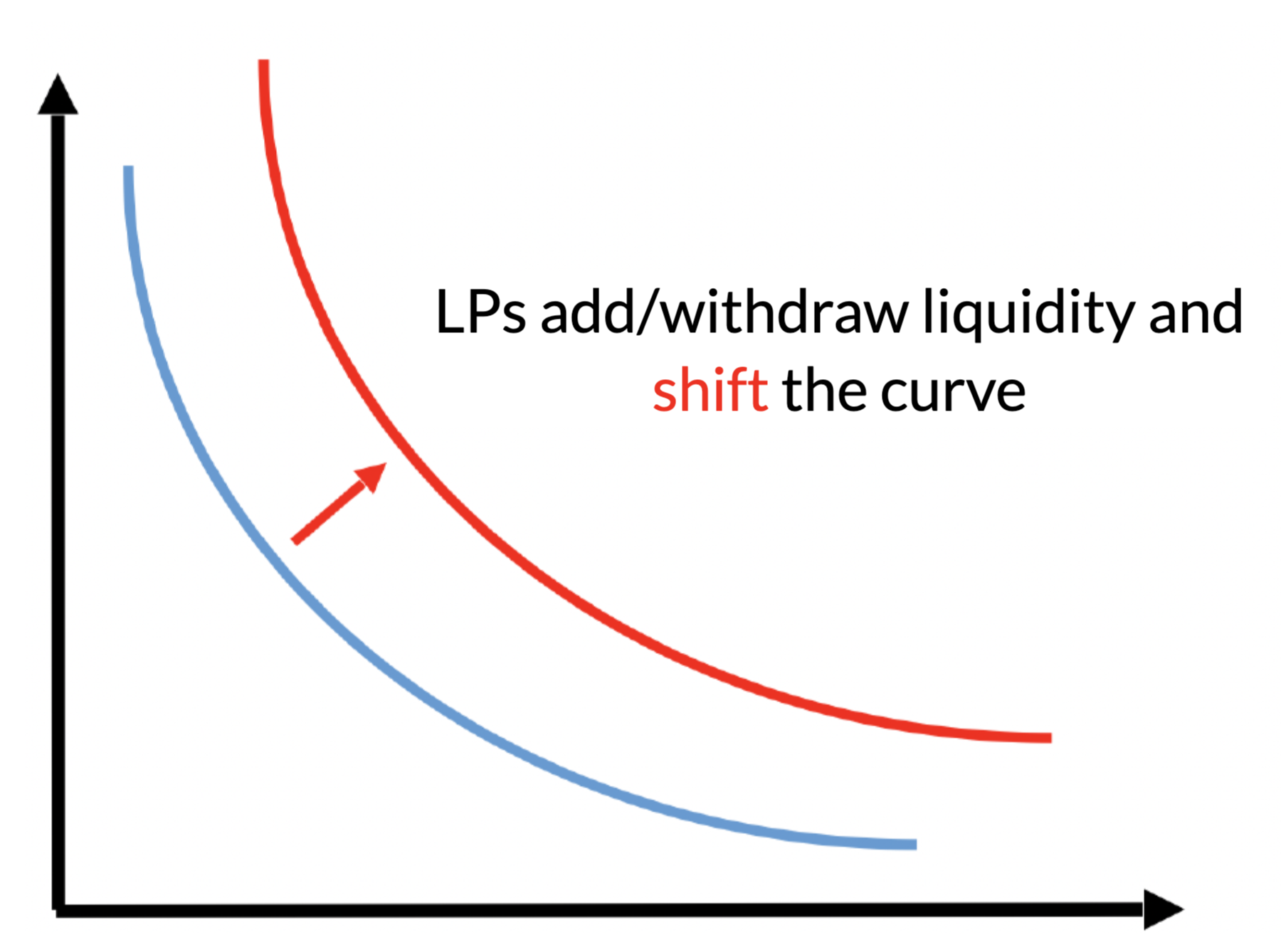
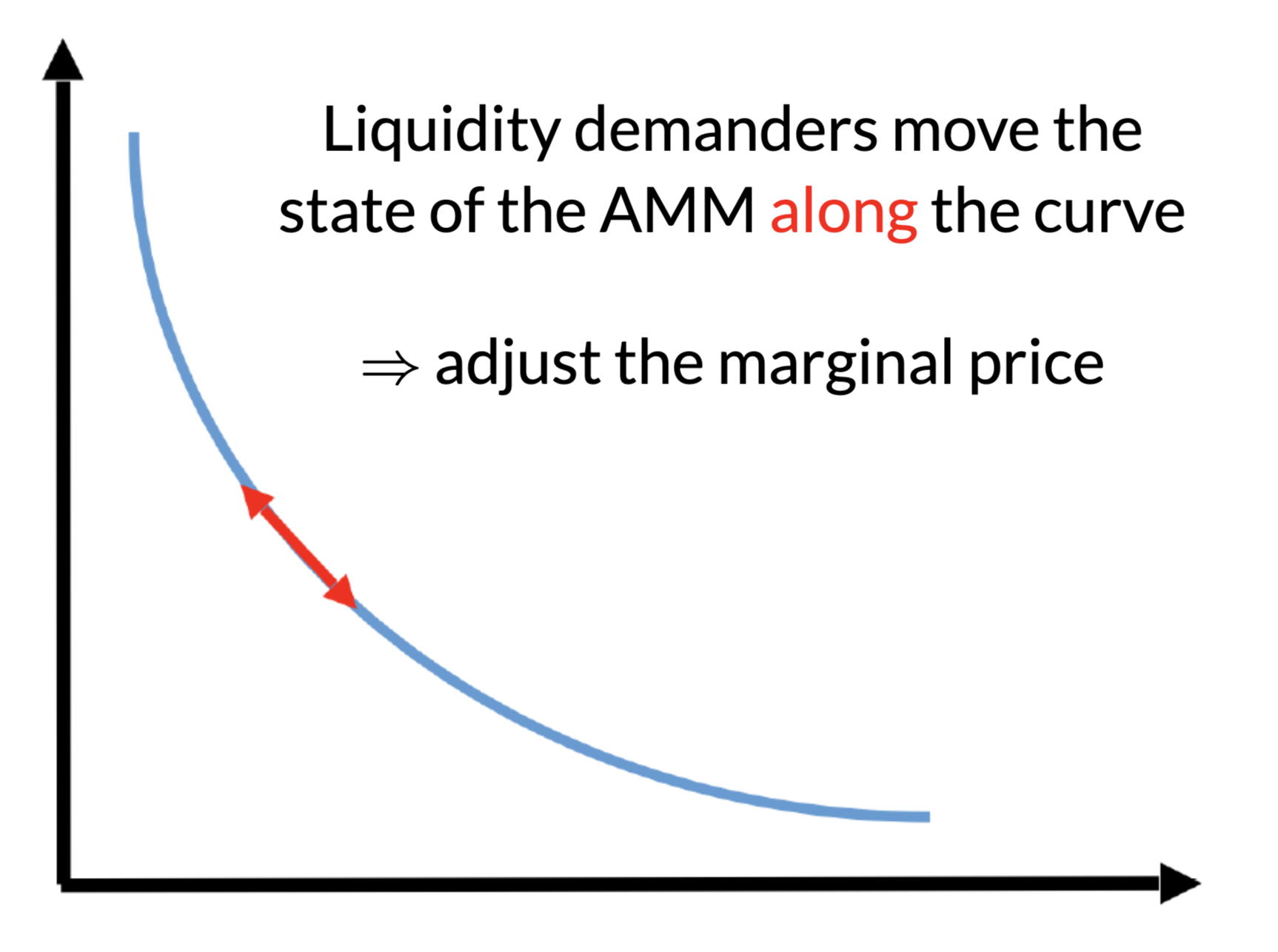
No effect on the marginal price
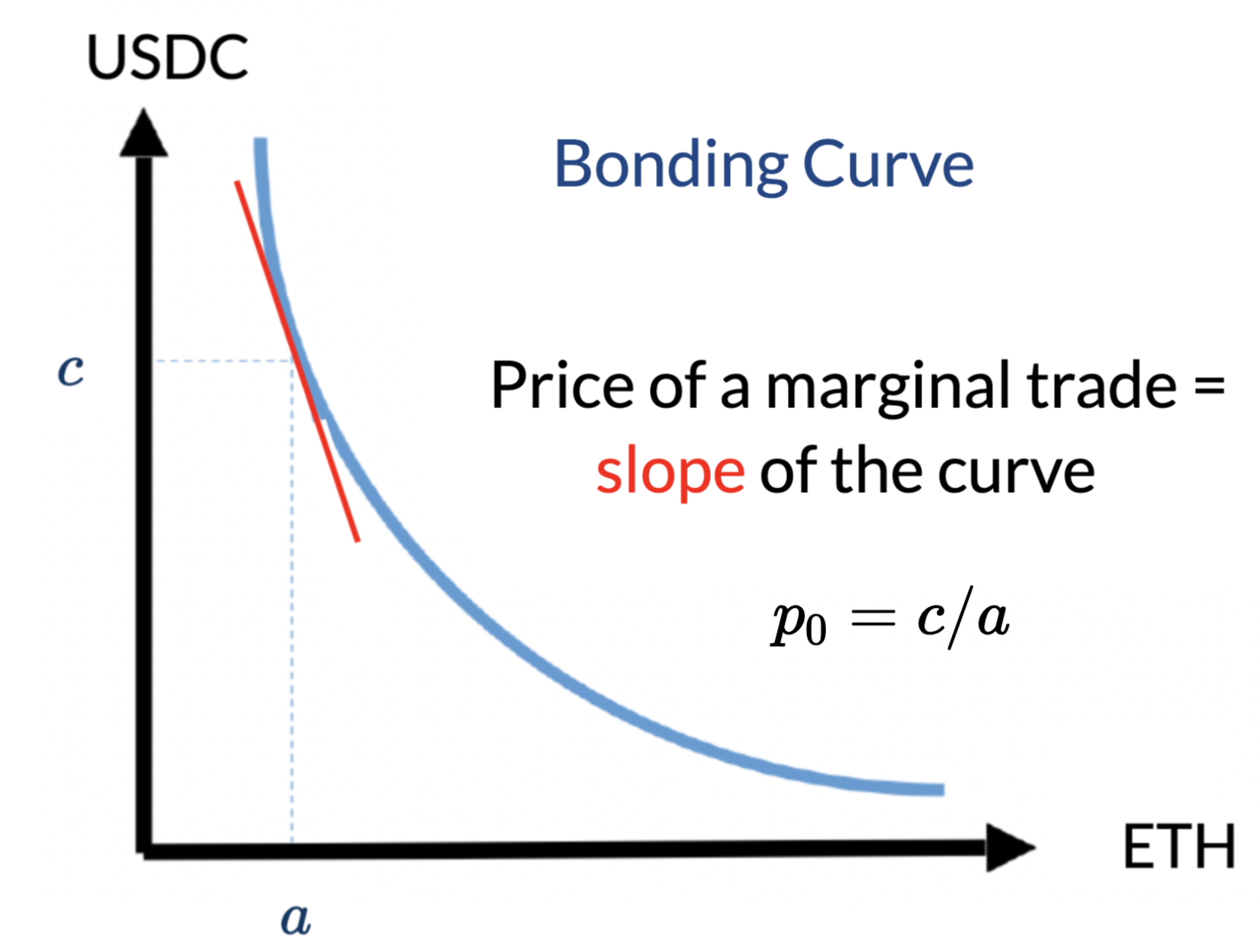
- Most common form of AMM liquidity rule is Constant Product Pricing
\[L(a,c)=a\cdot c~\Rightarrow~a\cdot c= (a-q)\cdot (c+\Delta c).\] - Total cost of trading \(q\) \[\Delta c=\frac{cq}{a-q}.\]
- Price per unit \[p(q)=\frac{c}{a-q}.\]
Liquidity providers: positional losses
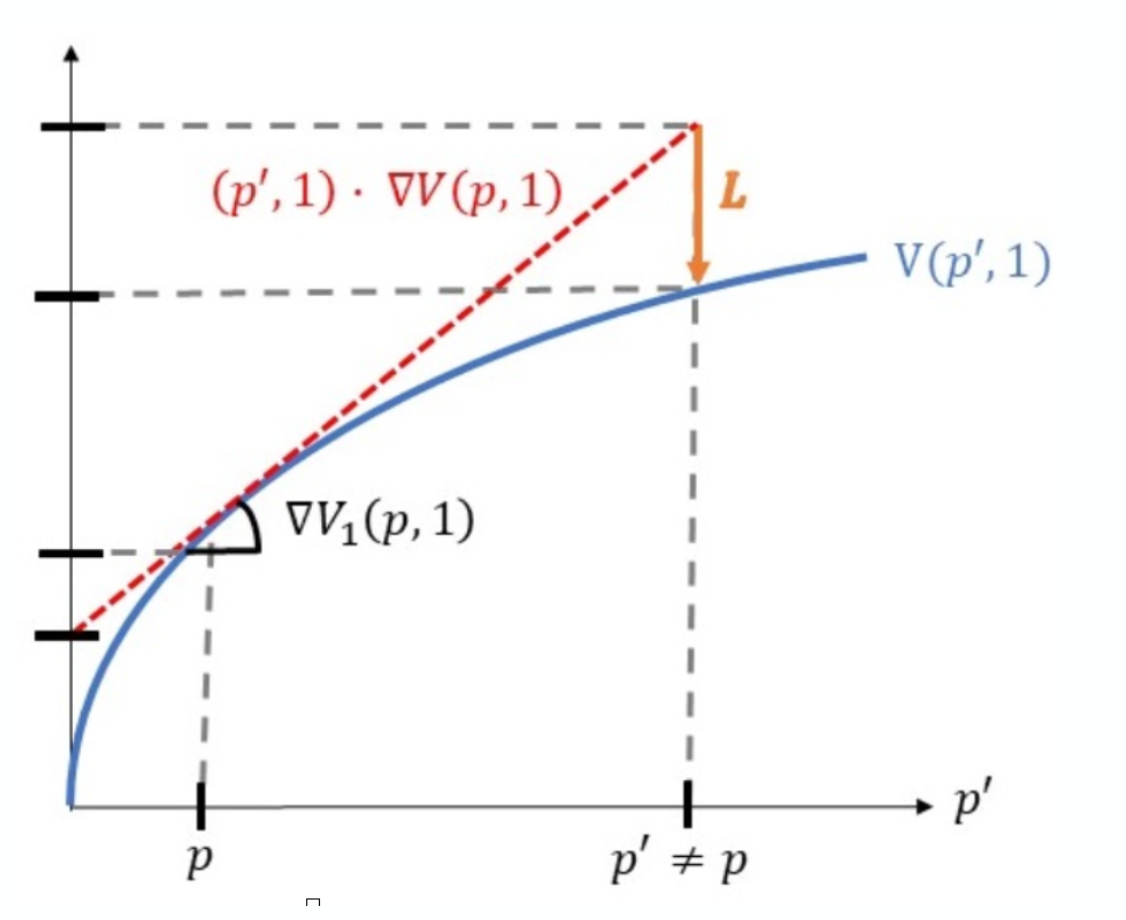
- Deposit asset & cash when the asset price is \(p\)
- Withdraw at price \(p'\ne p\)
Buy and hold
Provided liquidity
in the pool
- Why?
- adverse selection losses
- arbitrageurs trade to rebalance the pool
- \(\to\) always positional loss relative to a "buy-and-hold"
Constant Liquidity (Product) AMM
- Purchase \(q\) of asset
- Deposit cash \(\Delta c (q)\) into liquidity pool, extract \(q\) of shares
- Idea of pricing: liquidity before trade \(=\) after trade
\[L(a,c)=L(a-q,c+\Delta c)\]
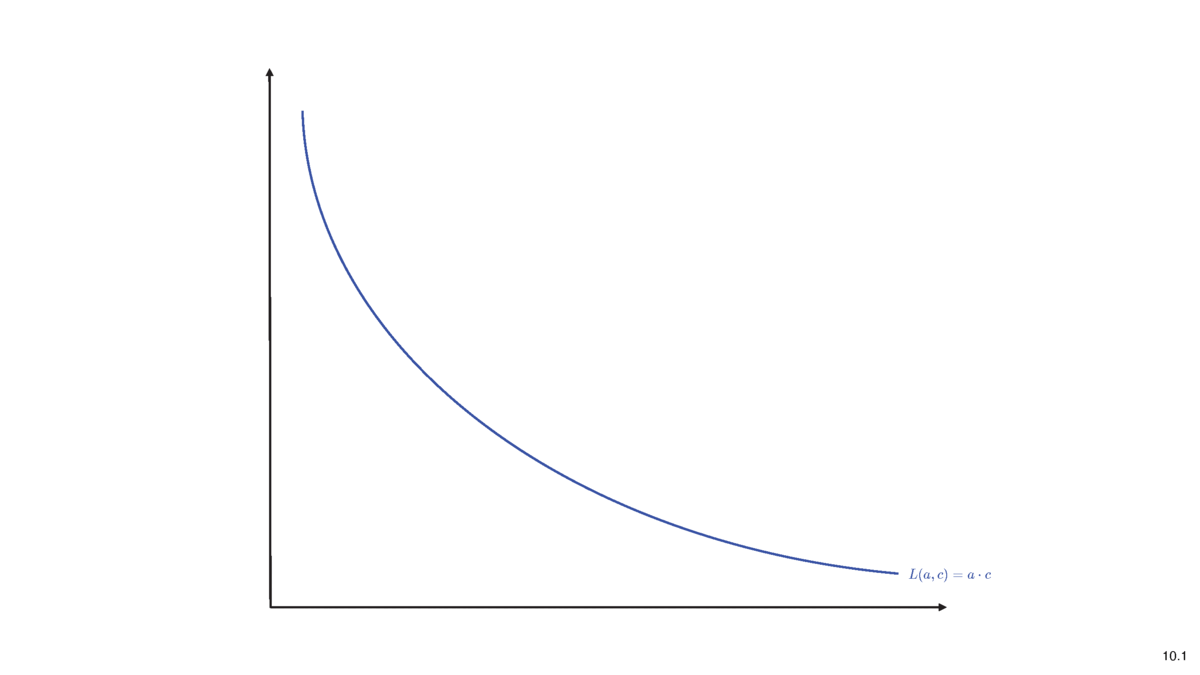
- AMMs require liquidity deposits
- Deposits:
- \(a\) units of an asset (e.g. a stock)
- \(c\) units of cash
The Pricing Function
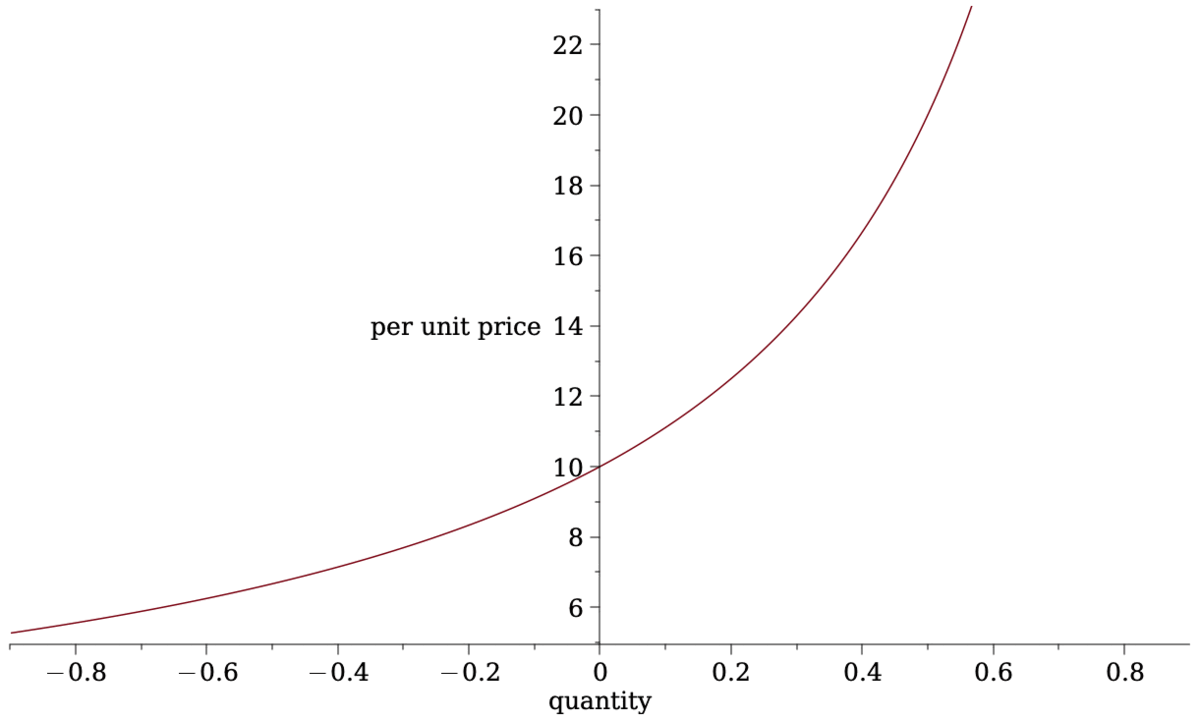
- Most common form of AMM liquidity rule is Constant Product Pricing
\[L(a,c)=a\cdot c~\Rightarrow~a\cdot c= (a-q)\cdot (c+\Delta c).\] - Total cost of trading \(q\) \[\Delta c=\frac{cq}{a-q}.\]
- Price per unit \[p(q)=\frac{c}{a-q}.\]
- Average spread paid\[\frac{p(q)}{p(0)}-1=\frac{q}{a-q}.\]
- liquidity provider makes asset and cash deposit
- more deposits flatten price curve
- may attract more volume
- but larger "positional" dollar loss when prices move
- larger liquidity deposits \(a\) \(\Rightarrow\)
- lower costs (price impact) for liquidity demanders



| limit order book | periodic auctions | AMM | |
|---|---|---|---|
| continuous trading |
|||
| price discovery with orders | |||
| risk sharing |
|||
| passive liquidity provision | |||
| price continuity |
|||
| continuous liquidity | |||
| sniping prevented |










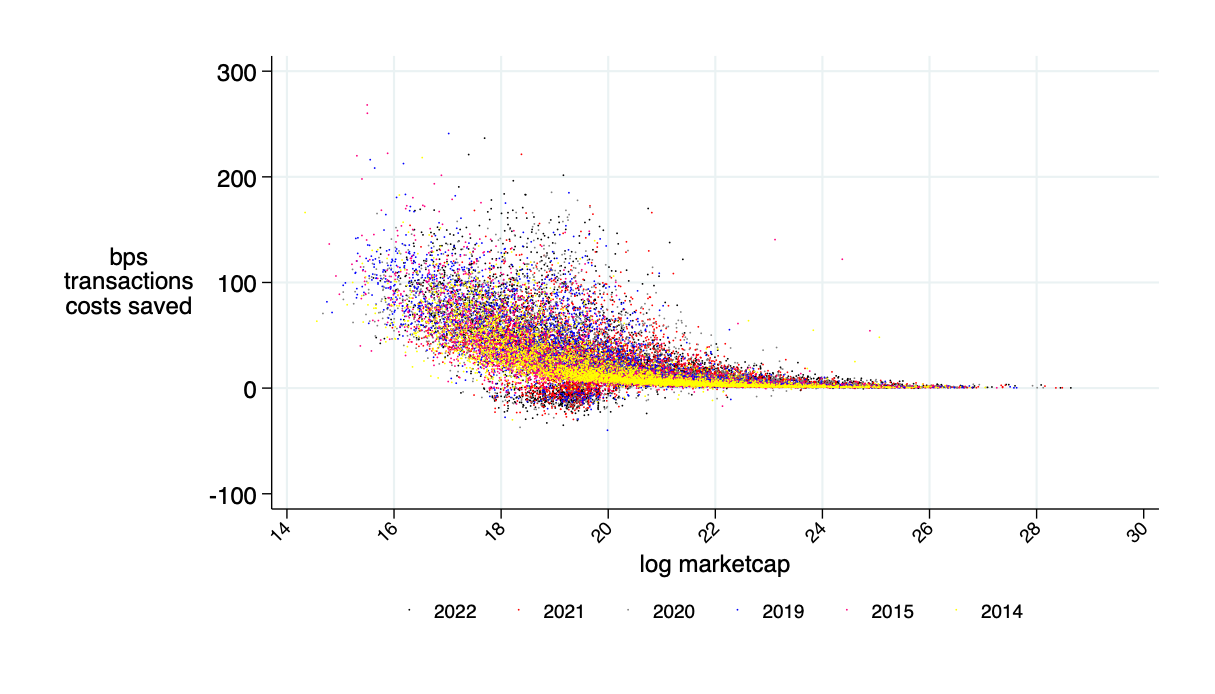
Source of savings:
- better risk sharing among liquidity providers
- better use of capital
Possible transaction cost savings when applied to equity trading: \(\approx\) 30%
Source: "Learning from DeFi: Would Automated Market Makers Improve Equity Trading?" working paper, Malinova & Park 2023
Converting Assets to Cash: MakerDAO














\(\vdots\)
formally: this smart contract is a collateralized debt position (CDP)

- create fiat money on chain with borrowing
- a collateralized loan with ETH in escrow
The User's Perspective for a DAI Loan
fractional collateral \(\to\) collateralization factor \(=\) 150%
total collateral = $1,500
maximum loan = $1000
overcollateralization = $500
actual loan (example) = $500
buffer = $500
The User's Perspective for a DAI Loan
ETH \(\nearrow\) $500
value of ETH collateral = $2,000
maximum loan = $2,000/150%=$1,333
total collateral = $2,000
maximum loan = $1,333
overcollateralization = $667
actual loan (example) = $500
buffer = $500
overcollateralization = $667
new loan capacity= $333
User Perspective: what if the price of ETH rises?
ETH \(\searrow\) $187.5
value of ETH collateral = $750
maximum loan = $750/150%=$500
total collateral = $750
maximum loan = $500
overcollateralization = $250
actual loan (example) = $500
buffer = $0
for reference: former value of collateral
User Perspective: what if the price of ETH falls?
ETH \(\searrow\) $150
value of ETH collateral = $600
maximum loan = $600/150%=$400
total collateral = $600
maximum loan = $400
required overcollateralization = $200
actual loan (example) = $500
buffer = -$100
for reference: former value of collateral
\(\Rightarrow\) triggering of liquidation auction by "keeper"
sell 3.33 ETH=$500=500 DAI
repay $500=500 DAI loan
retain incentive
return remainding ETH to vault owner
Pool-based lending principles












borrow
provide collateral
Application: Pool-based borrowing and lending
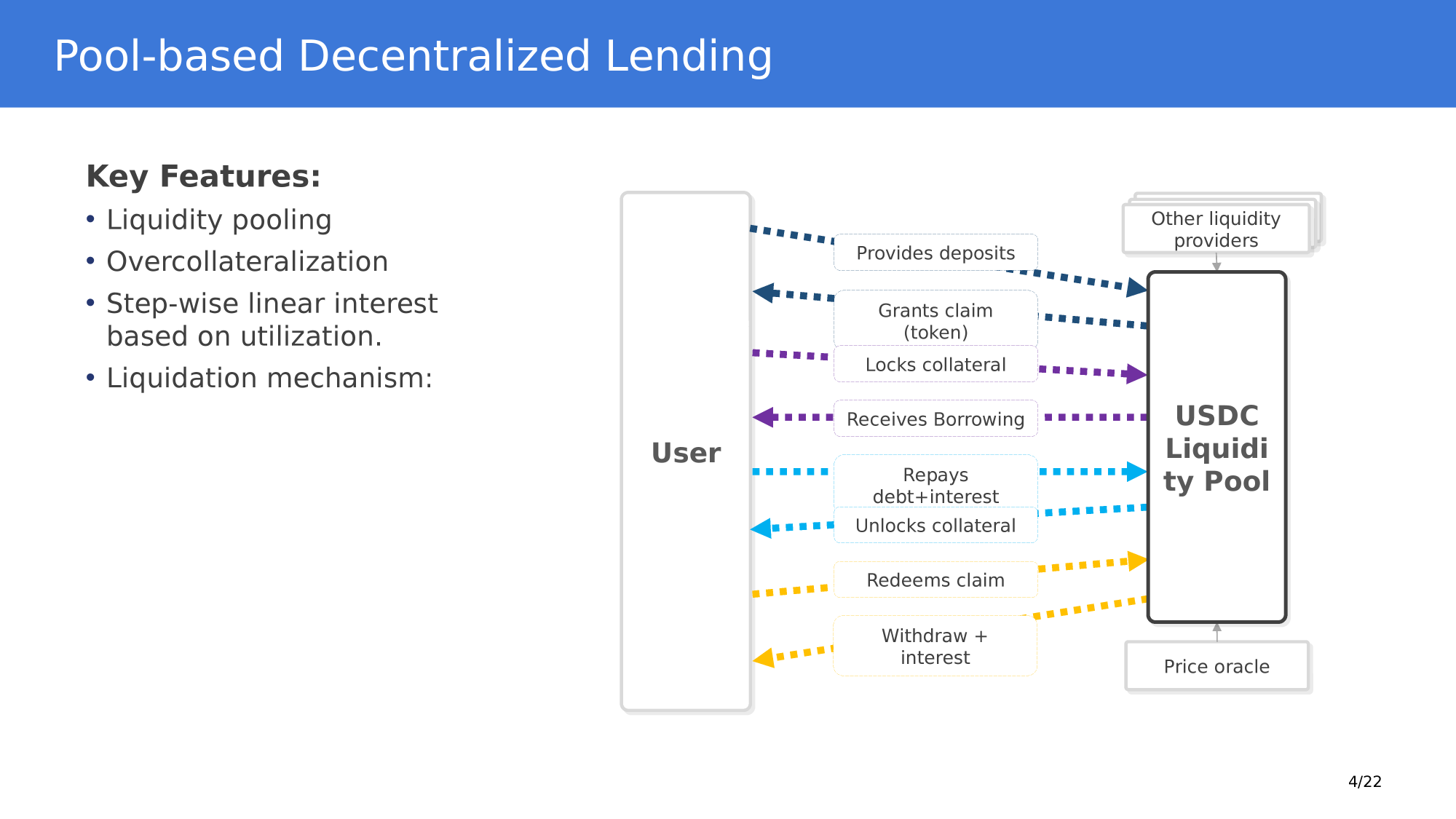
Application: Decentralized Borrowing & Lending
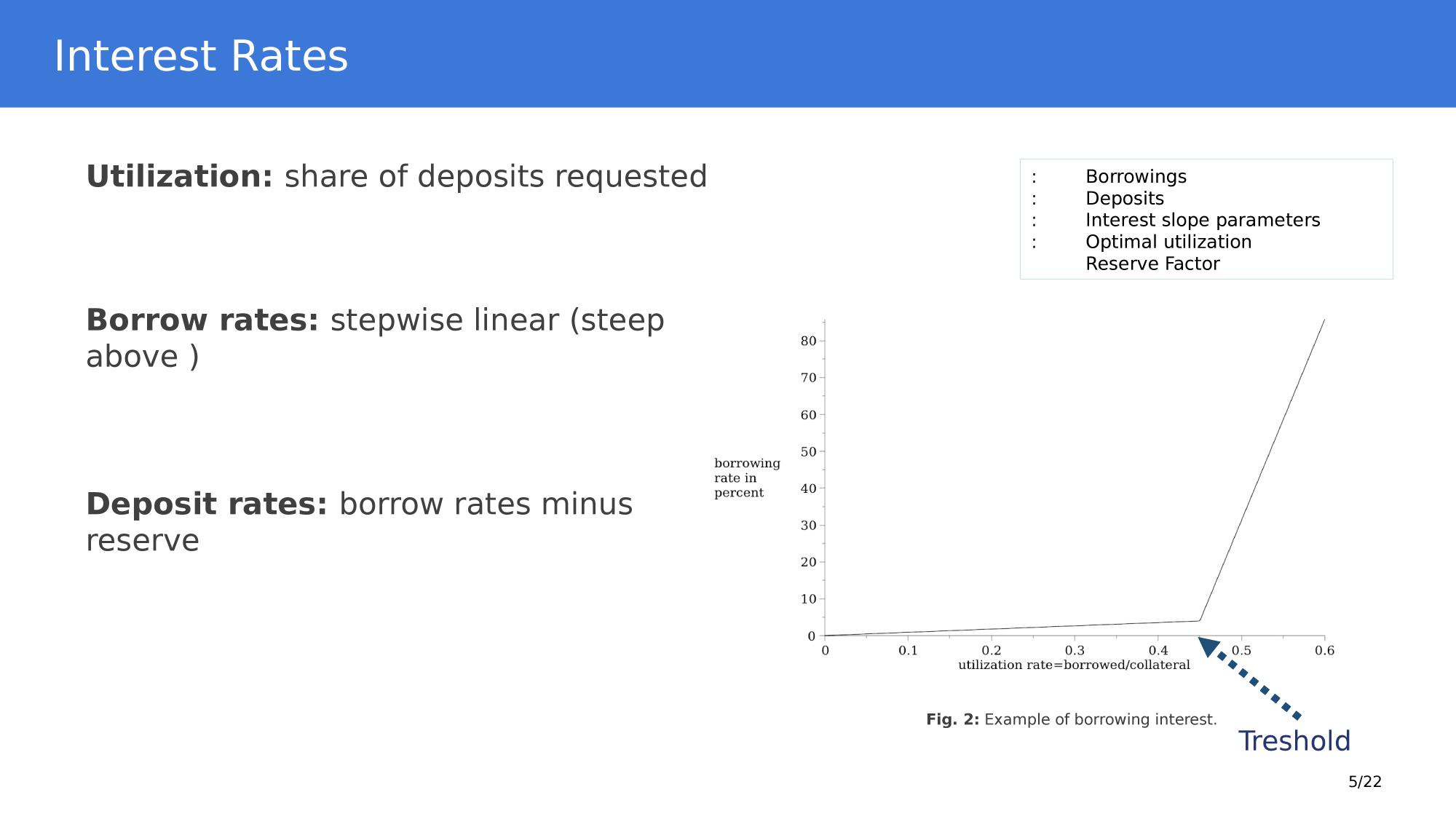
Interest rates
threshold/target utilization
Collateral Condition
- borrowers have a "health factor"
- idea: how much risk-adjusted collateral did they provide relative to loan
- risk adjustment is mechanical by a lending factor = how much can you borrow per dollar of collateral
- Examples:
- Stablecoin: borrow 90 cents per $1
- ETH: borrow 60 cents per $1
- Low health factor loans can be liquidated
Flash Loans

5. repay DAI



for loan
with health factor <1
liquidation
opportunity


1. flash-borrow DAI
2. repay loan
with DAI


3. claim
collateral ETH

4. convert ETH to DAI

Liquidity Mining: Priming the Pump
liquidity \(\nearrow\)
volume \(\nearrow\)
protocol fees \(\nearrow\)
token value \(\nearrow\)
Platform economics is tricky:
- What's the product?
- How do you get it started?
- How do you get people to contribute?
- How do you earn money?
Without intermediaries:
platform economics!
incentives for both?
A Taxonomy of Tokens
- tokens are a re-imagination of value, ownership, use, rewards
-
tokens live on a single infrastructure and can interact with other tokens
- tokens are immediately transferable & immediately usable in DeFi
- token can be programmed to have many features and have many different uses
- tokens can assign ownership to "things" that could not be owned before
- tokens are often important for the functioning and incentives of platforms
What's a crypto-token and what's special about it?
- a blockchain is a protocol in which
- users have direct control and responsibility over their assets
- users can create codes at will
- \(\rightarrow\) any user can create tokens and applications
Tokens by use
payments:
- you use them strictly to pay for something
- example: native cryptocurrencies
utility
- you use them to access a specific service of function
- example: filecoin
stablecoins
- digital representation of fiat money
- centralized/ decentralized
- examples: DAI, USDC, USDT
governance
- voting rights to determine parameters of a project
- example: UNI, Compound etc
asset
- representation of ownership
- pool claims, digital items
- example: receipts from UniSwap, Compound, NFTs
derivatives
- tokens based on other tokens & functions
- Example: tokensets
Disclaimer: this list in non-exhaustive, new ideas and concepts come up every day!
Stablecoins

pulled from Nick Carter's talk on "Will stablecoins serve or subvert U.S. interests?"
BTC, ETH
HQLA: USD, EUR
asset (gold)
fee-backed
Seigniorage
Crypto
Traditional
Algorithmic
Collateral-Backed
Taxonomy of Stablecoins
DEPOSITS
other assets
JPM coin
USDC
USDT
TUSD
DAI, FEI
What makes a Stablecoin stable?
Case 1: price(1 SC) \(>\) 1 FU \(\to\) SC expensive
collateralized stablecoin






arbitrageur
issuer






market
Case 2: price(1 SC) \(<\) 1 FU \(\to\) SC cheap
collateralized stablecoin



arbitrageur
issuer

market








every issued token has a corresponding HQLA amount

Algorithmic Stablecoin: UST on Terra
Case 2: price(1 SC) \(<\) 1 FU \(\to\) SC cheap
under-collateralized stablecoin



arbitrageur
issuer

market








- arbitrageur purchases should raise price in market
- BUT:
- will is rise fast enough?
- does the issuer have enough funds or, rather have funds for long enough?
- for fully decentralized algo/smart contract stablecoin: there is no dollar to give!

Case 1: price(1 SC) \(>\) 1 FU \(\to\) SC cheap


arbitrageur
issuer
- for fully decentralized algo/smart contract stablecoin: there is no dollar to give!
The Case of Luna-Terra



exchange LUNA for newly minted UST tokens at the prevailing $ market rate





market
LUNA market








Case 2: price(1 SC) \(<\) 1 FU \(\to\) SC cheap


arbitrageur
issuer
- for fully decentralized algo/smart contract stablecoin: there is no dollar to give!
The Case of Luna-Terra




exchange SC for newly minted LUNA tokens at the prevailing $ market rate

market




LUNA market










Case 2: price(1 SC) \(<\) 1 FU \(\to\) SC cheap
DISCUSSION
- backing/collateral is the value of the LUNA/Terra Network
- \(\to\) must have value(Terra)\(\ge\sum\) SC
- when you issue new LUNA tokens
- shift value from current to new owners
- create inflation\(\to\) price(Luna)\(\searrow\)
POTENTIAL PROBLEMS
- value(Terra)\(<\sum\) SC
- could be pre-drop SC
- when SC<FU, LUNA token holders
- know price(LUNA) will drop
- \(\to\) pre-emptive selling
- more LUNA issued
- \(\to\) more inflation
- \(\to\) more price drops
- \(\to\) DEATH SPIRAL!!!
- So far there has never been an algorithmic stablecoin that did not collapse.
- Disclaimer: I am not aware of a mathematical proof that an algo stablecoin cannot work.
Stablecoin use cases
What do central bankers think about stablecoins?

BIS Survey of Central Banks:

What do central bankers think about stablecoins?

Stablecoin use cases
- Domestic
- developed world: do things you otherwise can't do
- developing world: everything
- stablecoins as payments compete with existing rails
- factors for adoption are
- price
- convenience
- reach/applications
- interoperability (e.g., credit availability, acceptance)
- International
- move assets faster and cheaper
- do things banks can't/won't do




Source: On-chain Foreign Exchange and Cross-border Payments by Austin Adams, Mary-Catherine Lader, Gordon Liao, David Puth, Xin Wan (2023) [team from UniSwap Labs]
DeFi fees:
- fiat to crypto on ramp: 0%-1%
- exchange fees 1-5bps
- network fee: $0.001-5$
- off-ramp fee: 0%-1%
- total: from close to 0 to 2%+$5
Central Bank-Issued Digital Currencies
Evolution




Source: CBDCtracker.org
Possible CBDC architectures



Source: BIS Quarterly Review, March 2020
Technological Limitations
Challenge 1: Environment

- Carbon footprint of Switzerland
- Power consumption of Austria

problem solved
| transactions per second | T per 12 hours (business day) | |
|---|---|---|
| Bitcoin | 7 | 302,400 |
| Ethereum | 30 | 1,296,000 |
| Algorand | 2000 | 86,400,000 |
| Avalanche | 5000 | 216,000,000 |
| US retail payments | 7639 | 330,000,000 |
Challenge 2: Throughput

Solution 2: Rollups

- rollups can add millions of transactions per day
- gas usage \(= \frac{1}{500}\) of mainnet
- other chains (BNB, Polygon) process several million transaction per day
Challenge 3: State Size
Source: Ycharts

Settlement Layer









































a
b
c
d
e
f
g







The Role of the Settlement Layer

Solutions and Remedies
- Flashbots protocol
- encrypted transactions
- FHE Protocol
Stinky Business: Hacks & Exploits
Risk is in every layer of the tech stack!
- Network Layer
- DDoS attacks etc.
- Blockchain Layer
- Sybil attacks
- MEV
- Smart Contract Layer
- Malicious code
- Bug exploits
- Interface Layer
- Oracle attacks
- Malicious plug-ins
- 2FA SIM attacks

hot wallet hack (Sept 2023)


Hacker minted WETH out of thin air on Solana's contract since signatures were not verified! Bridge attack
Hacker remotely stole validator private keys
Bridge attack
Remedies?
- Centralized auditing (as a service)
- Blockchain layer
- Smart contract layer
- OK, but audits based on past "lessons"
- In-house testing
- OK, but limited coverage of cases
- Symbolic and formal verification
- Expensive but probably the future
Why are Blockchains challenging for current regulation?
The Investment Process
issuers
investors
- funding
- record-keeping
- instruments
- custody
- advice
- trading
services
needed & provided
- takes care of custody and allows self-custody
- allows instrument creation
- enables record-keeping
- allows circumvention of existing institutions
A general purpose value management infrastructure:
intermediaries
separate institutions
- asset custodians
- broker-dealers
- trading platforms
The blockchain reality:
new institutions
emerged that do all three
tokens are often not intended to be investments!
Who controls the Projects? Decentralized Autonomous organizations

UniSwap Lab supports development

a website app accesses the code

token holders control contact features
don't own the code
operation = decentral
control = decentral
anyone can use the baseline code



core code runs on the blockchain

tokens used as rewards
Final Thoughts
Some Final Thoughts
- blockchain tech won't get uninvented.
- young people and universities keep working on blockchain ideas
- the space is still trying to figure things out, including tech and economic challenges
- great progress has been made, but things will and do still go wrong
- a common resource can have huge economic benefits
- I'd like to see more thinking and discussion about paths to unlock the benefits
@financeUTM
andreas.park@rotman.utoronto.ca

slides.com/ap248
sites.google.com/site/parkandreas/
youtube.com/user/andreaspark2812/